Behavior and Reliable Design Methods of Axial Compressed Dune Sand Concrete-Filled Circular Steel Tube Columns
Abstract
:1. Introduction
2. Finite Element Modeling
2.1. Element Type, Interaction, Boundary Conditions, and Mesh
2.2. The Steel Constitutive Model
2.3. The Dune Sand Concrete Constitutive Model
2.4. Model Validation
3. Finite Element Analysis
3.1. Parametric Analysis
3.2. Confinement Analysis and Effectiveness Evaluation
3.2.1. Infilled DS Concrete Strength
3.2.2. Steel Strength
3.2.3. Cross-Sectional Steel Ratio
3.2.4. DS Replacement Ratio
3.3. Axial Compression Comparison of CFCST and DS-CFCST Stub Columns
4. Practical Formula for Bearing Capacity and Reliability Analysis
4.1. Model Simplification
4.2. Formulation
4.3. Formula Validation
4.4. Comparison of Formulas
4.5. Reliability Analysis
4.5.1. Reliability Analysis Method
- Normal variable:
- 2.
- Log-normal variable:
- 3.
- Type I extreme value distribution:
4.5.2. Reliability Analysis Steps
- Variable Identification for Reliability Index: This includes cross-sectional dimensions (D), tube wall thickness (t), load effects (SGk, SQk), model uncertainty (kp), concrete strength (fc), and steel strength (fy). Statistical analysis of kp is performed.
- Resistance Calculation (Nu,r): Varying material strength values are substituted into Equation (10) to determine Nu,r.
- Load Effect Determination: Based on the formula Nu,r ≥ S = γGSGk + γQSQk and the load effect ratio ρL = SQk/SGk, calculate the standard value of the dead load effect SGk = Nu,r/(γG + ρLγQ) and the standard value of the live load effect SQk = ρLSGk.
- MATLAB Random Sampling: Random sampling of D, t, SGk, SQk, kp, fc, fy, and Nu,r is performed N times (N ≥ 100/pf) in MATLAB. These values are then used into limit state Equation (15).
- Reliability Index Calculation (β): The number of instances where Z < 0 is counted, and β is calculated using Equation (17). Error estimation is carried out with Equation (18).
4.5.3. Statistical Parameters of Basic Random Variables
- Statistical parameters of load
- 2.
- Statistical parameters of geometric dimensions
- 3.
- Statistical Parameters of Material Properties
- 4.
- Calculation models’ statistical uncertainty parameters
4.5.4. Reliability Analysis Results
5. Conclusions
- FE model results show good agreement with experimental data, evidenced by a mean value of Nu,Exp/Nu,FE at 1.008 and a CV of 0.040. Load–axial strain curves from the FE analysis align closely with experimental observations, confirming the model’s validity.
- The strength of the infilled DS concrete, steel yield strength, and steel ratio significantly influence the ultimate bearing capacity of DS-CFCST stub columns. Conversely, the DS replacement ratio has a minor impact on load-bearing capacity.
- This study highlights the diminishing effect of DS replacement ratio on steel tube confinement efficacy. However, the relative influence of this factor is minimal compared to other design parameters.
- A simplified, straightforward formula for predicting the axial load-bearing capacity of DS-CFCST columns is proposed. This formula, incorporating a steel tube shape confinement factor, aligns well with experimental and FE-derived results, offering a more accurate and simpler alternative to existing design code formulas.
- Reliability analysis supports balanced design approaches, considering material strengths, reinforcement ratios, loading conditions, and DS replacement ratio. This ensures adherence to the target reliability index, emphasizing the necessity of adequate safety margins against failure in structural systems.
Author Contributions
Funding
Data Availability Statement
Conflicts of Interest
References
- Goldberg, S. Demand for Frac Sand and Concrete Drives Scarcity. Available online: https://www.investopedia.com/investing/demand-frac-sand-and-concrete-drives-scarcity/ (accessed on 13 July 2024).
- Bendixen, M.; Best, J.; Hackney, C.; Iversen, L.L. Time Is Running out for Sand. Nature 2019, 571, 29–31. [Google Scholar] [CrossRef] [PubMed]
- Goyal, S. Soaring Sand Prices Adversely Impact Residential Projects. Available online: https://www.99acres.com/articles/soaring-sand-prices-adversely-impact-residential-projects.html (accessed on 13 July 2024).
- Al-Harthy, A.S.; Halim, M.A.; Taha, R.; Al-Jabri, K.S. The Properties of Concrete Made with Fine Dune Sand. Constr. Build. Mater. 2007, 21, 1803–1808. [Google Scholar] [CrossRef]
- Alhozaimy, A.; Jaafar, M.S.; Al-Negheimish, A.; Abdullah, A.; Taufiq-Yap, Y.H.; Noorzaei, J.; Alawad, O.A. Properties of High Strength Concrete Using White and Dune Sands under Normal and Autoclaved Curing. Constr. Build. Mater. 2012, 27, 218–222. [Google Scholar] [CrossRef]
- Seif, E.S.S.A. Assessing the Engineering Properties of Concrete Made with Fine Dune Sands: An Experimental Study. Arab. J. Geosci. 2013, 6, 857–863. [Google Scholar] [CrossRef]
- Luo, F.J.; He, L.; Pan, Z.; Duan, W.H.; Zhao, X.L.; Collins, F. Effect of Very Fine Particles on Workability and Strength of Concrete Made with Dune Sand. Constr. Build. Mater. 2013, 47, 131–137. [Google Scholar] [CrossRef]
- Zaitri, R.; Bederina, M.; Bouziani, T.; Makhloufi, Z.; Hadjoudja, M. Development of High Performances Concrete Based on the Addition of Grinded Dune Sand and Limestone Rock Using the Mixture Design Modelling Approach. Constr. Build. Mater. 2014, 60, 8–16. [Google Scholar] [CrossRef]
- Liu, H.-F.; Chen, Q.-L.; Fu, J. Mechanical Properties of Desert Sand High Strength Concrete with Different Desert Sand Replacement Ratio and Fly Ash Dosage. Adv. Mater. Technol. Appl. 2016, 203–208. [Google Scholar] [CrossRef]
- Li, Y.; Zhang, H.; Liu, G.; Hu, D.; Ma, X. Multi-Scale Study on Mechanical Property and Strength Prediction of Aeolian Sand Concrete. Constr. Build. Mater. 2020, 247, 118538. [Google Scholar] [CrossRef]
- Lynda Amel, C.; Kadri, E.H.; Sebaibi, Y.; Soualhi, H. Dune Sand and Pumice Impact on Mechanical and Thermal Lightweight Concrete Properties. Constr. Build. Mater. 2017, 133, 209–218. [Google Scholar] [CrossRef]
- Liu, H.; Chen, X.; Che, J.; Liu, N.; Zhang, M. Mechanical Performances of Concrete Produced with Desert Sand after Elevated Temperature. Int. J. Concr. Struct. Mater. 2020, 14, 26. [Google Scholar] [CrossRef]
- Damene, Z.; Goual, M.S.; Houessou, J.; Dheilly, R.M.; Goullieux, A.; Quéneudec, M. The Use of Southern Algeria Dune Sand in Cellular Lightweight Concrete Manufacturing: Effect of Lime and Aluminium Content on Porosity, Compressive Strength and Thermal Conductivity of Elaborated Materials. Eur. J. Environ. Civ. Eng. 2018, 22, 1273–1289. [Google Scholar] [CrossRef]
- Yan, W.; Wu, G.; Dong, Z. Optimization of the Mix Proportion for Desert Sand Concrete Based on a Statistical Model. Constr. Build. Mater. 2019, 226, 469–482. [Google Scholar] [CrossRef]
- Li, Y.; Zhang, H.; Liu, X.; Liu, G.; Hu, D.; Meng, X. Time-Varying Compressive Strength Model of Aeolian Sand Concrete Considering the Harmful Pore Ratio Variation and Heterogeneous Nucleation Effect. Adv. Civ. Eng. 2019, 2019, 5485630. [Google Scholar] [CrossRef]
- Zhang, G.; Song, J.; Yang, J.; Liu, X. Performance of Mortar and Concrete Made with a Fine Aggregate of Desert Sand. Build. Environ. 2006, 41, 1478–1481. [Google Scholar] [CrossRef]
- Benabed, B.; Kadri, E.H.; Azzouz, L.; Kenai, S. Properties of Self-Compacting Mortar Made with Various Types of Sand. Cem. Concr. Compos. 2012, 34, 1167–1173. [Google Scholar] [CrossRef]
- Zhu, L.; Zheng, M.; Zhang, S.; Zhang, W.; Chen, W.; Ou, Z. Modification and Mechanism of Polymer in High-Performance Concrete with Full Aeolian Sand: An Integrated Macro-to-Micro Perspective. J. Build. Eng. 2023, 75, 106969. [Google Scholar] [CrossRef]
- Hamada, H.M.; Abed, F.; Al-Sadoon, Z.A.; Elnassar, Z.; Hassan, A. The Use of Treated Desert Sand in Sustainable Concrete: A Mechanical and Microstructure Study. J. Build. Eng. 2023, 79, 107843. [Google Scholar] [CrossRef]
- Park, S.; Lee, E.; Ko, J.; Yoo, J.; Kim, Y. Rheological Properties of Concrete Using Dune Sand. Constr. Build. Mater. 2018, 172, 685–695. [Google Scholar] [CrossRef]
- Wang, W.H.; Han, L.H.; Li, W.; Jia, Y.H. Behavior of Concrete-Filled Steel Tubular Stub Columns and Beams Using Dune Sand as Part of Fine Aggregate. Constr. Build. Mater. 2014, 51, 352–363. [Google Scholar] [CrossRef]
- Ren, Q.X.; Zhou, K.; Hou, C.; Tao, Z.; Han, L.H. Dune Sand Concrete-Filled Steel Tubular (CFST) Stub Columns under Axial Compression: Experiments. Thin-Walled Struct. 2018, 124, 291–302. [Google Scholar] [CrossRef]
- Li, Z.; Ma, R.; Li, G. Experimental Study on the Shear Strength of Dune Sand Concrete Beams. Adv. Civ. Eng. 2020, 2020, 8062691. [Google Scholar] [CrossRef]
- Li, Z.; Yang, S.; Luo, Y. Experimental Evaluation of the Effort of Dune Sand Replacement Levels on Flexural Behaviour of Reinforced Beam. J. Asian Archit. Build. Eng. 2020, 19, 480–489. [Google Scholar] [CrossRef]
- Li, Z.; Gan, D. Cyclic Behavior and Strength Evaluation of RC Columns with Dune Sand. J. Build. Eng. 2022, 47, 103801. [Google Scholar] [CrossRef]
- Li, Z.; Zhai, D.; Li, J. Seismic Behavior of the Dune Sand Concrete Beam-Column Joints under Cyclic Loading. Structures 2022, 40, 1014–1024. [Google Scholar] [CrossRef]
- Guo, Z.; Qin, Y.; Zhang, Y.; Li, X. Experimental Investigation on Shear Behavior of Dune Sand Reinforced Concrete Deep Beams. Appl. Sci. 2023, 13, 3466. [Google Scholar] [CrossRef]
- Han, L.H.; Li, W.; Bjorhovde, R. Developments and Advanced Applications of Concrete-Filled Steel Tubular (CFST) Structures: Members. J. Constr. Steel Res. 2014, 100, 211–228. [Google Scholar] [CrossRef]
- Han, L.H.; Tao, Z.; Huang, H.; Zhao, X.L. Concrete-Filled Double Skin (SHS Outer and CHS Inner) Steel Tubular Beam-Columns. Thin-Walled Struct. 2004, 42, 1329–1355. [Google Scholar] [CrossRef]
- Chen, Z.; Xu, J.; Chen, Y.; Lui, E.M. Recycling and Reuse of Construction and Demolition Waste in Concrete-Filled Steel Tubes: A Review. Constr. Build. Mater. 2016, 126, 641–660. [Google Scholar] [CrossRef]
- De Nardin, S.; El Debs, A.L.H.C. Axial Load Behaviour of Concrete-Filled Steel Tubular Columns. Struct. Build. 2007, 160, 13–22. [Google Scholar] [CrossRef]
- Patel, V.I. Analysis of Uniaxially Loaded Short Round-Ended Concrete-Filled Steel Tubular Beam-Columns. Eng. Struct. 2020, 205, 110098. [Google Scholar] [CrossRef]
- Ci, J.; Ahmed, M.; Liang, Q.Q.; Chen, S.; Chen, W.; Sennah, K.; Hamoda, A. Experimental and Numerical Investigations into the Behavior of Circular Concrete-Filled Double Steel Tubular Slender Columns. Eng. Struct. 2022, 267, 114644. [Google Scholar] [CrossRef]
- Ahmed, M.; Sheikh, M.N.; Hadi, M.N.S.; Liang, Q.Q. Nonlinear Analysis of Square Spiral-Confined Reinforced Concrete-Filled Steel Tubular Short Columns Incorporating Novel Confinement Model and Interaction Local Buckling. Eng. Struct. 2023, 274, 115168. [Google Scholar] [CrossRef]
- Han, L.H.; Yao, G.H.; Zhao, X.L. Tests and Calculations for Hollow Structural Steel (HSS) Stub Columns Filled with Self-Consolidating Concrete (SCC). J. Constr. Steel Res. 2005, 61, 1241–1269. [Google Scholar] [CrossRef]
- Tao, Z.; Wang, Z.-B.; Yu, Q. Finite Element Modelling of Concrete-Filled Steel Stub Columns under Axial Compression. J. Constr. Steel Res. 2013, 89, 121–131. [Google Scholar] [CrossRef]
- Ding, F.X.; Liu, J.; Liu, X.M.; Yu, Z.W.; Li, D.W. Mechanical Behavior of Circular and Square Concrete Filled Steel Tube Stub Columns under Local Compression. Thin-Walled Struct. 2015, 94, 155–166. [Google Scholar] [CrossRef]
- Ding, F.; Cao, Z.; Lyu, F.; Huang, S.; Hu, M.; Lin, Q. Practical Design Equations of the Axial Compressive Capacity of Circular CFST Stub Columns Based on Finite Element Model Analysis Incorporating Constitutive Models for High-Strength Materials. Case Stud. Constr. Mater. 2022, 16, e01115. [Google Scholar] [CrossRef]
- Bahati, M. Experimental Study on Axial Compression Mechanical Properties of Desert Sand Concrete Filled Steel Tubular Short Columns. Master’s Thesis, Xinjiang University, Urumqi, China, 2019. [Google Scholar]
- Sadat, S.I.; Ding, F.; Lyu, F.; Lessani, N.; Liu, X.; Yang, J. Unified Prediction Models for Mechanical Properties and Stress-Strain Relationship of Dune Sand Concrete. Comput. Concr. 2023, 32, 595–606. [Google Scholar] [CrossRef]
- Ding, F.; Wu, X.; Xiang, P.; Yu, Z. New Damage Ratio Strength Criterion for Concrete and Lightweight Aggregate Concrete. Struct. J. 2021, 118, 165–178. [Google Scholar] [CrossRef]
- Ding, F.; Sadat, S.I.; Lyu, F.; Yin, Y. Flexural Performance of Rectangular CFST Composite T-Beams: Experimental, Numerical, and Theoretical Investigation. J. Constr. Steel Res. 2024, 213, 108356. [Google Scholar] [CrossRef]
- Sadat, S.I.; Ding, F.; Lyu, F.; Wang, E.; Sun, H.; Akhunzada, K.; Lessani, N. Axial Compression Behavior and Reliable Design Approach of Rectangular Dune Sand Concrete-Filled Steel Tube Stub Columns. Dev. Built Environ. 2024, 18, 100437. [Google Scholar] [CrossRef]
- Ding, F.X.; Yu, Z.W.; Bai, Y.; Gong, Y.Z. Elasto-Plastic Analysis of Circular Concrete-Filled Steel Tube Stub Columns. J. Constr. Steel Res. 2011, 67, 1567–1577. [Google Scholar] [CrossRef]
- ACI 318-11; American Concrete Institute Committee, Building Code Requirements for Structural Concrete and Commentary. American Concrete Institute: Farmington Hills, MI, USA, 2011; ISBN 9780870317453.
- AISC 360-16; Specification for Structural Steel Buildings. American Institute of Steel Construction: Chicago, IL, USA, 2016.
- BS EN 1994-1-1; Design of Steel Composite Steel and Concrete Structures, Part 1-1, General Rules and Rules for Building. British Standards Institution: London, UK, 2004.
- AIJ. Recommendations for Design and Construction of Concrete Filled Steel Tubular Structures; Architectural Institute of Japan: Tokyo, Japan, 1997. [Google Scholar]
- Ding, F.; Xiong, S.; Zhang, H.; Li, G.; Zhao, P.; Xiang, P. Reliability Analysis of Axial Bearing Capacity of Concrete Filled Steel Tubular Stub Columns with Different Cross Sections. Structures 2021, 33, 4193–4202. [Google Scholar] [CrossRef]
- GB50068-2018; Unified Standard for Reliability Design of Building Structures. Ministry of Construction of the People’s Republic of China: Beijing, China, 2018.
- GB50010-2010; Code for Design of Concrete Structures. Ministry of Construction of the People’s Republic of China: Beijing, China, 2010.
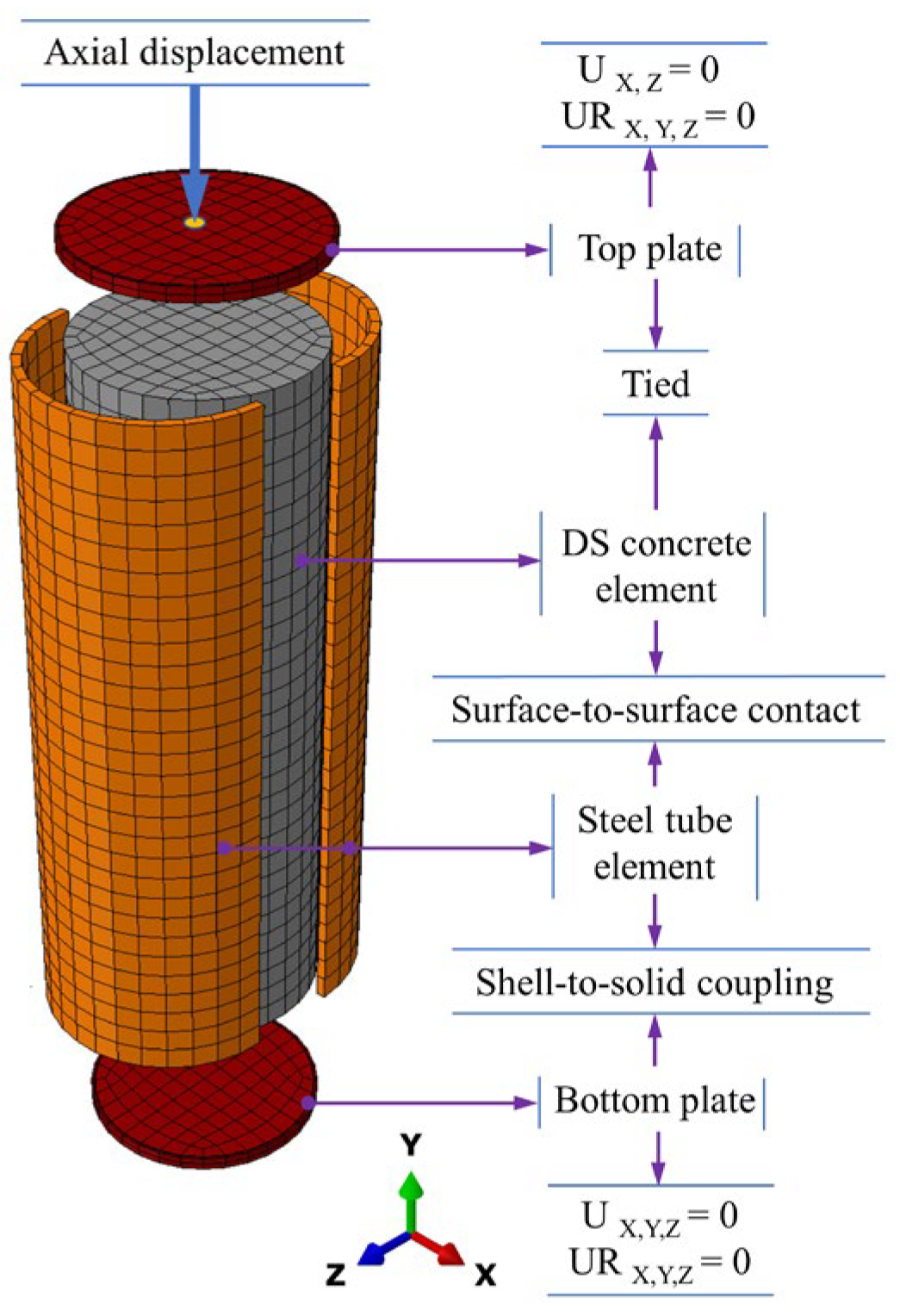

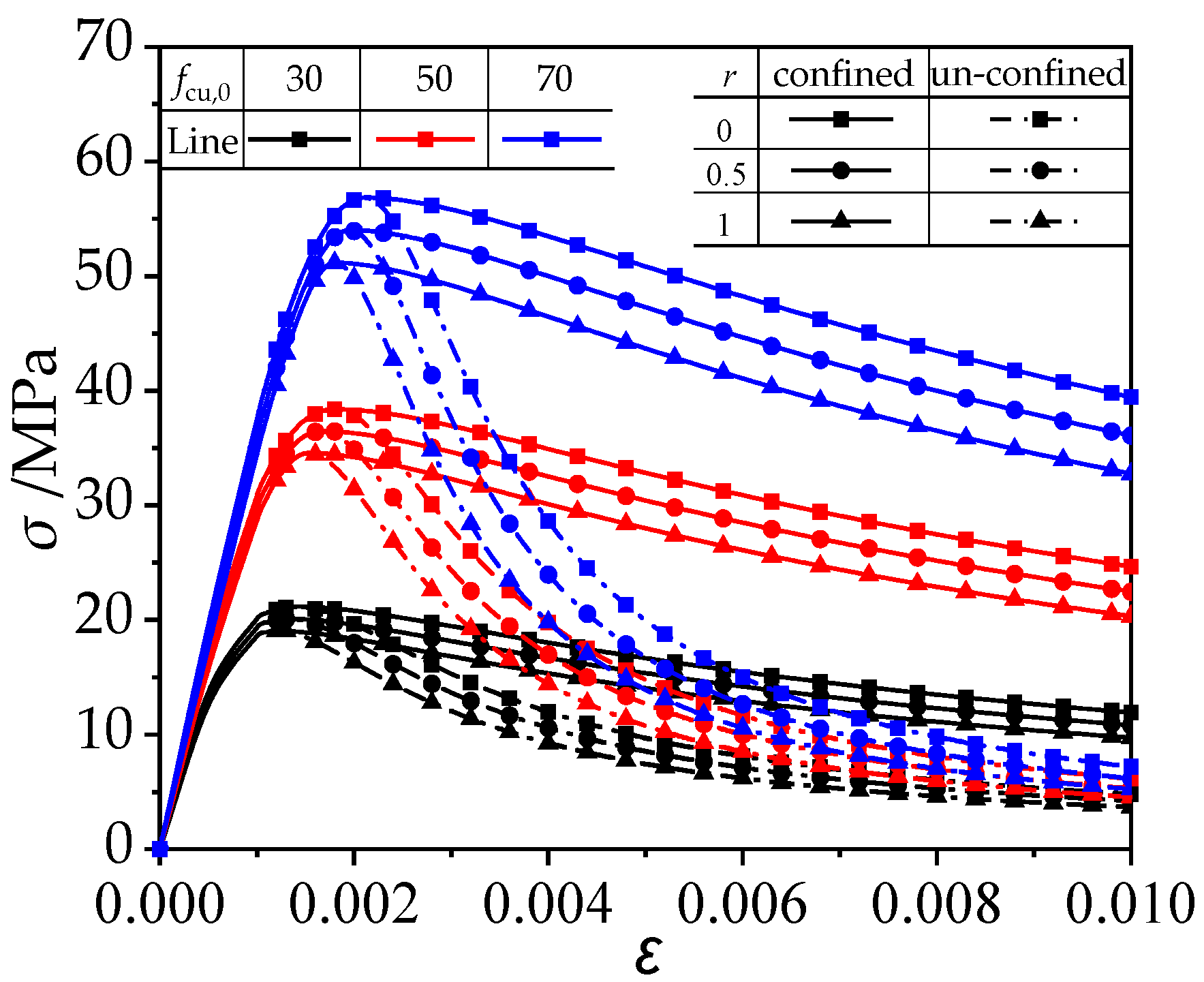
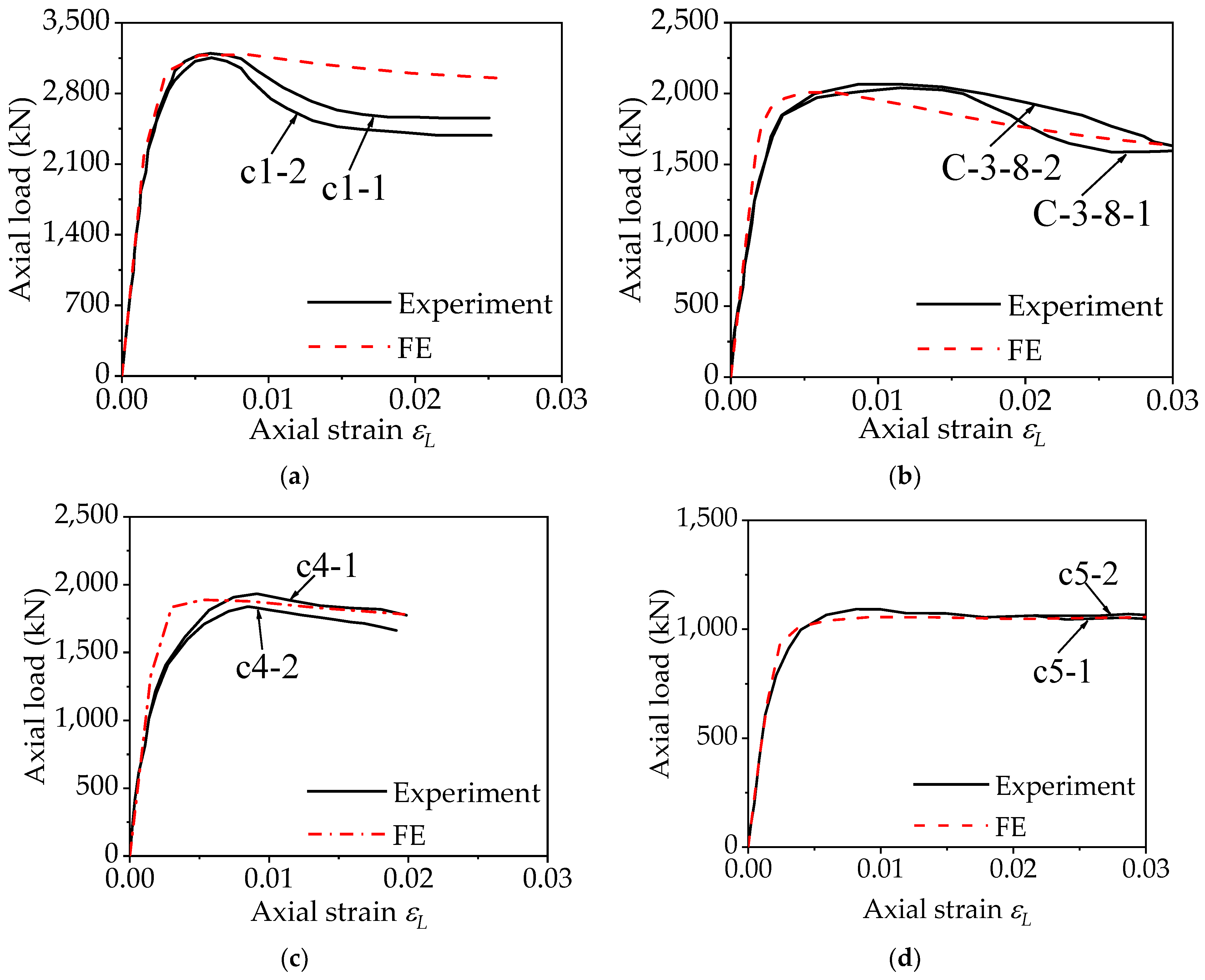


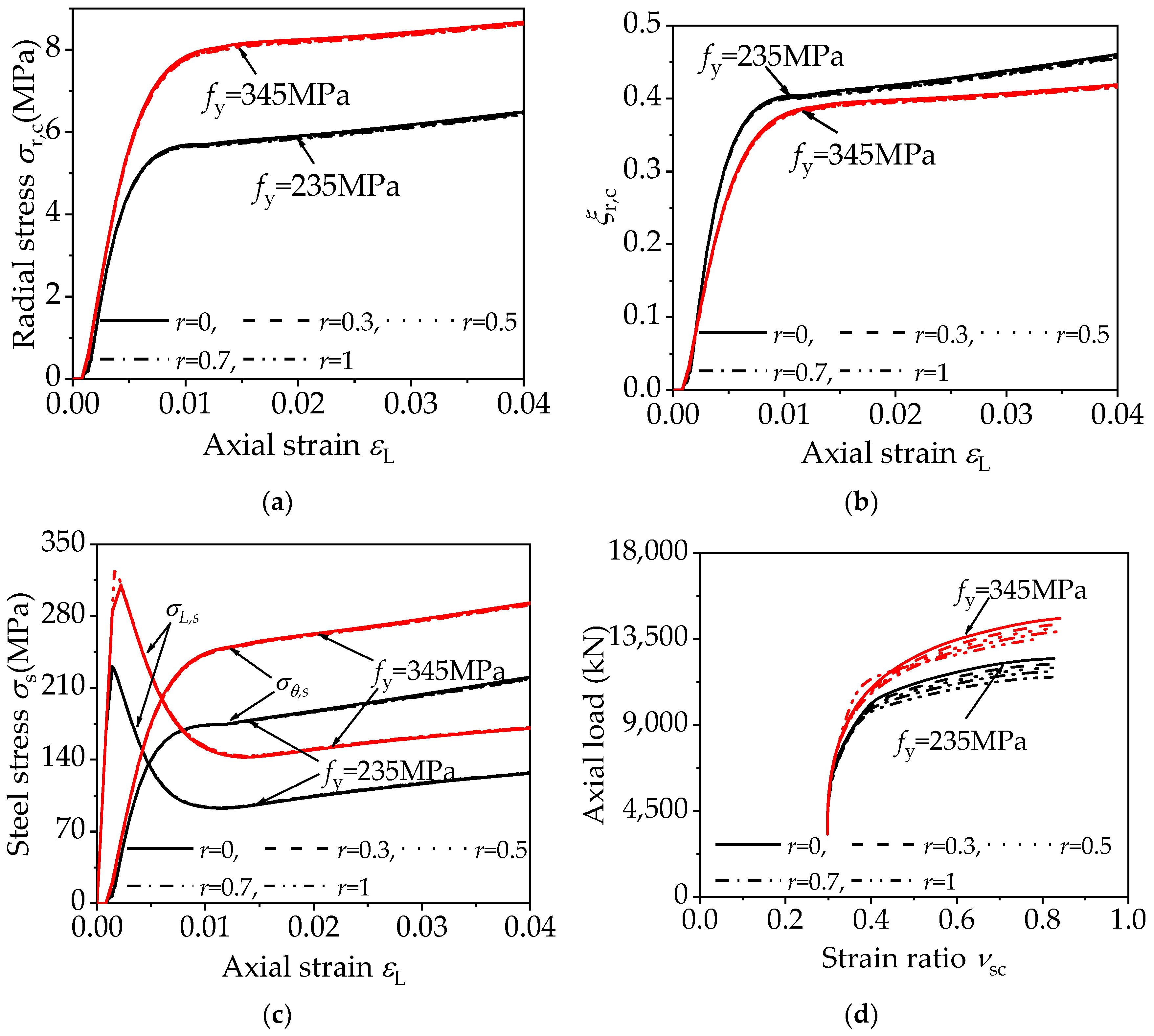
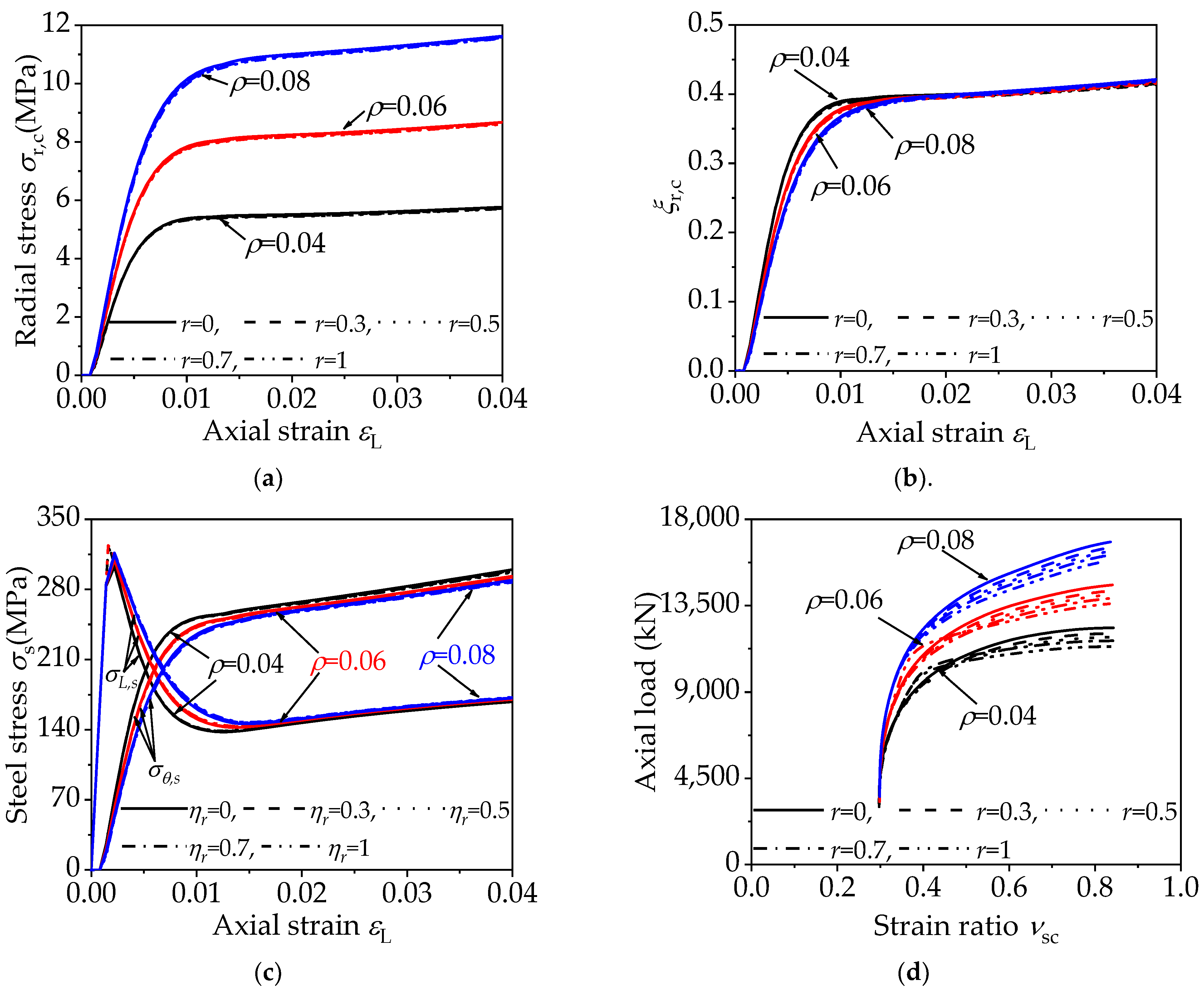
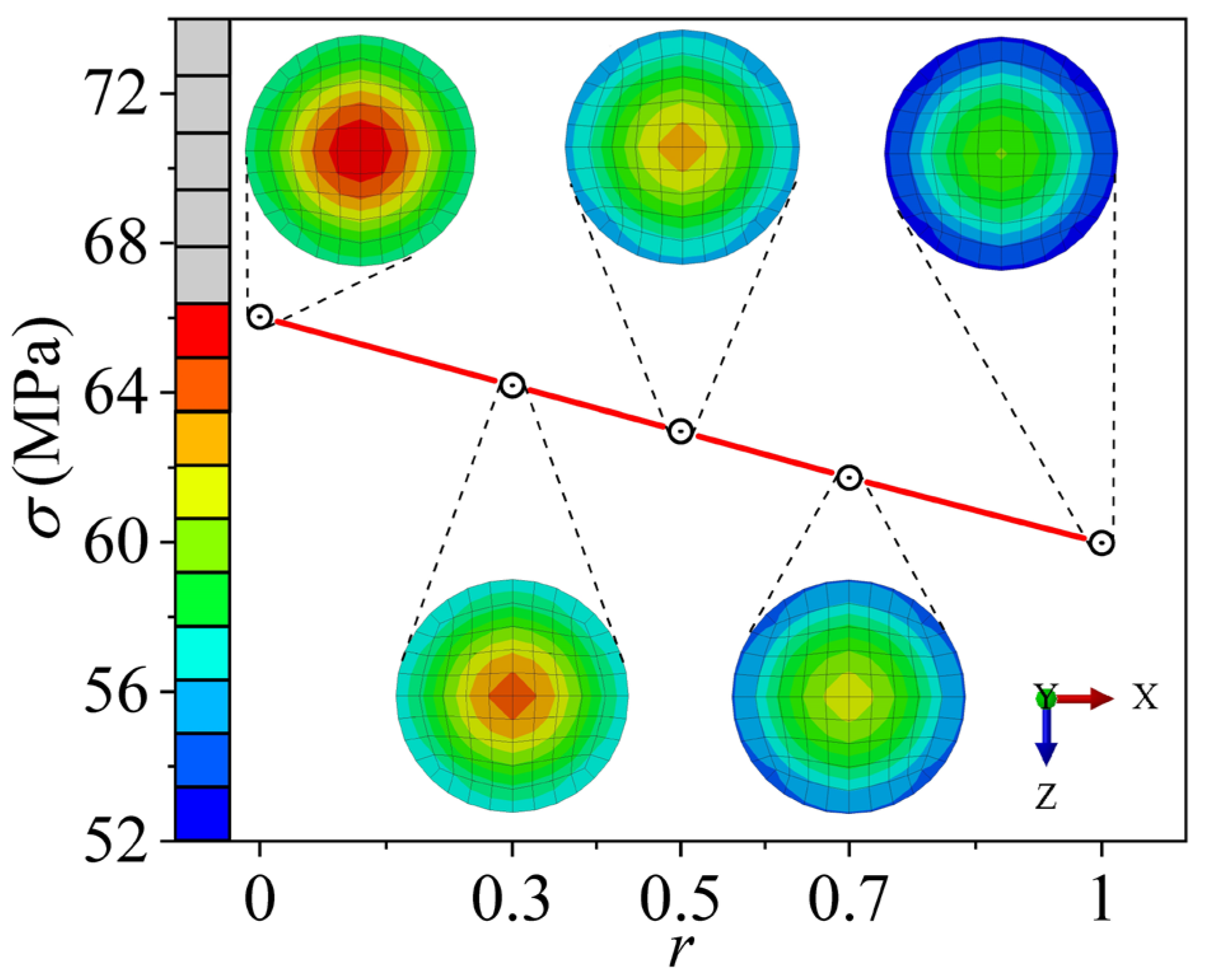


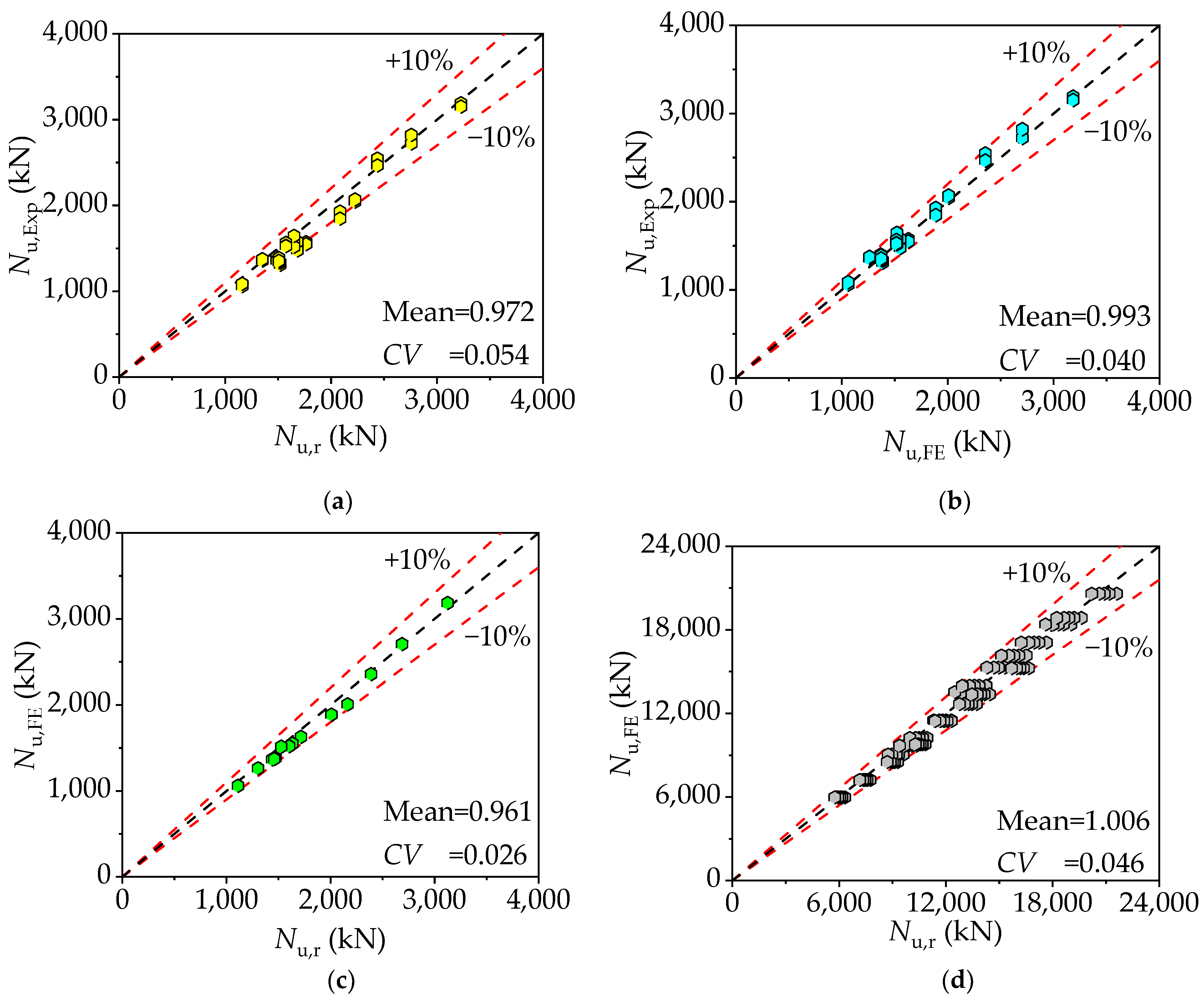
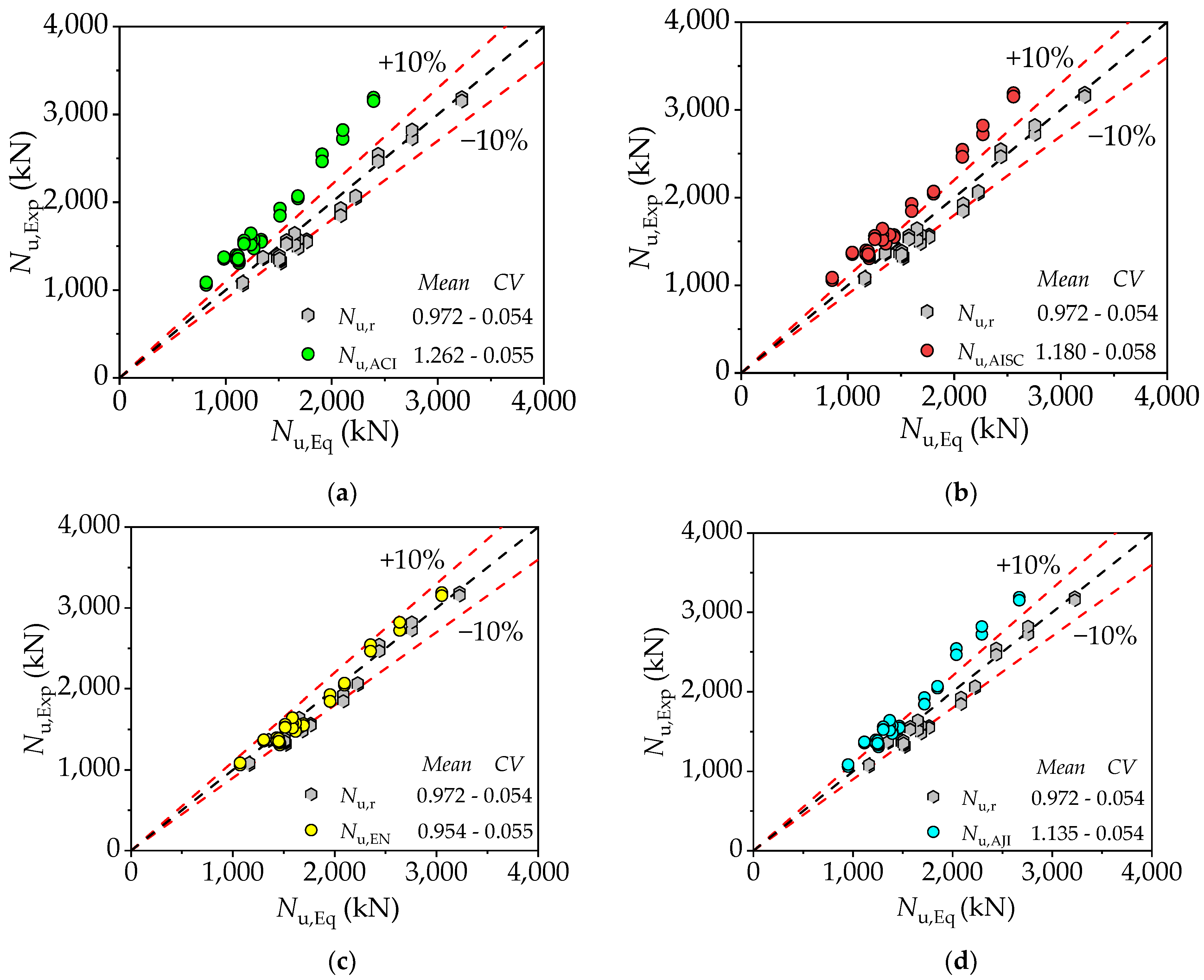
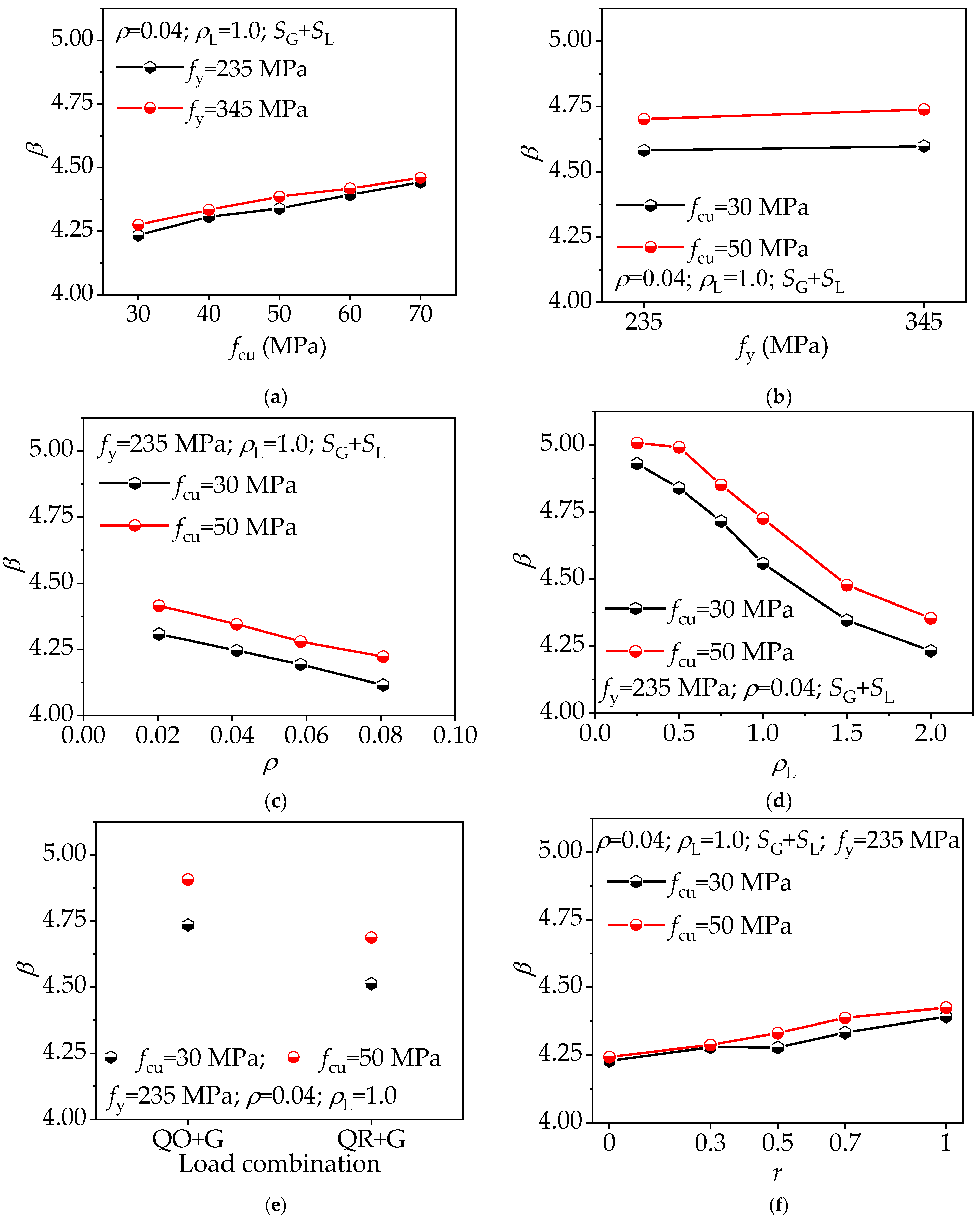
| Ecr | Poisson’s Ratio | Dilation Angle | e | fb0/fc0 | K | μ |
|---|---|---|---|---|---|---|
| (1 − 0.1r) 9500fcu1/3 | 0.2 | 40° | 0.1 | 1.277 | 2/3 | 0.0005 |
| Specimen Label | Ref. | D × t × L/mm | r | fcu,r (MPa) | fy (MPa) | Nu,Exp (kN) | Nu,FE (kN) | Nu,Exp/Nu,FE |
|---|---|---|---|---|---|---|---|---|
| C-3-8-1 | [21] | 160 × 3.46 × 520 | 0.1 | 78 | 363 | 2044 | 2008.36 | 1.018 |
| C-3-8-2 | 160 × 3.46 × 520 | 0.1 | 78 | 363 | 2069 | 2008.36 | 1.030 | |
| c1-1 | [22] | 200 × 3.82 × 600 | 1 | 65.8 | 432 | 3191 | 3184.42 | 1.002 |
| c1-2 | 200 × 3.82 × 600 | 1 | 65.8 | 432 | 3152 | 3184.42 | 0.990 | |
| c2-1 | 200 × 2.90 × 600 | 1 | 65.8 | 390 | 2722 | 2705.06 | 1.006 | |
| c2-2 | 200 × 2.90 × 600 | 1 | 65.8 | 390 | 2822 | 2705.06 | 1.043 | |
| c3-1 | 200 × 1.98 × 600 | 1 | 65.8 | 388 | 2546 | 2355.52 | 1.081 | |
| c3-2 | 200 × 1.98 × 600 | 1 | 65.8 | 388 | 2465 | 2355.52 | 1.046 | |
| c4-1 | 150 × 3.82 × 450 | 1 | 65.8 | 432 | 1927 | 1887.80 | 1.021 | |
| c4-2 | 150 × 3.82 × 450 | 1 | 65.8 | 432 | 1846 | 1887.80 | 0.978 | |
| c5-1 | 100 × 3.82 × 300 | 1 | 65.8 | 432 | 1097 | 1059.50 | 1.035 | |
| c5-2 | 100 × 3.82 × 300 | 1 | 65.8 | 432 | 1087 | 1059.50 | 1.026 | |
| DCFT3020-1 | [39] | 165 × 2.75 × 495 | 0.2 | 36.9 | 344.10 | 1362.08 | 1261.59 | 1.080 |
| DCFT3020-2 | 165 × 2.75 × 495 | 0.2 | 36.9 | 344.10 | 1355.95 | 1261.59 | 1.075 | |
| DCFT3020-3 | 165 × 2.75 × 495 | 0.2 | 36.9 | 344.10 | 1373.26 | 1261.59 | 1.089 | |
| DCFT3040-1 | 165 × 2.75 × 495 | 0.4 | 45.4 | 344.10 | 1397.42 | 1367.02 | 1.022 | |
| DCFT3040-2 | 165 × 2.75 × 495 | 0.4 | 45.4 | 344.10 | 1354.69 | 1367.02 | 0.991 | |
| DCFT3040-3 | 165 × 2.75 × 495 | 0.4 | 45.4 | 344.10 | 1355.52 | 1367.02 | 0.992 | |
| DCFT3060-1 | 165 × 2.75 × 495 | 0.6 | 47.4 | 344.10 | 1326.13 | 1384.66 | 0.958 | |
| DCFT3060-2 | 165 × 2.75 × 495 | 0.6 | 47.4 | 344.10 | 1307.63 | 1384.66 | 0.944 | |
| DCFT3060-3 | 165 × 2.75 × 495 | 0.6 | 47.4 | 344.10 | 1333.71 | 1384.66 | 0.963 | |
| DCFT30100-1 | 165 × 2.75 × 495 | 1 | 46.7 | 344.10 | 1386.47 | 1371.71 | 1.011 | |
| DCFT30100-2 | 165 × 2.75 × 495 | 1 | 46.7 | 344.10 | 1339.31 | 1371.71 | 0.977 | |
| DCFT30100-3 | 165 × 2.75 × 495 | 1 | 46.7 | 344.10 | 1353.74 | 1371.71 | 0.987 | |
| DCFT5020-1 | [39] | 165 × 2.75 × 495 | 0.2 | 60.2 | 344.10 | 1554.74 | 1628.95 | 0.954 |
| DCFT5020-2 | 165 × 2.75 × 495 | 0.2 | 60.2 | 344.10 | 1572.32 | 1628.95 | 0.965 | |
| DCFT5020-3 | 165 × 2.75 × 495 | 0.2 | 60.2 | 344.10 | 1547.99 | 1628.95 | 0.950 | |
| DCFT5040-1 | 165 × 2.75 × 495 | 0.4 | 56.1 | 344.10 | 1501.40 | 1551.12 | 0.968 | |
| DCFT5040-2 | 165 × 2.75 × 495 | 0.4 | 56.1 | 344.10 | 1475.20 | 1551.12 | 0.951 | |
| DCFT5040-3 | 165 × 2.75 × 495 | 0.4 | 56.1 | 344.10 | 1576.20 | 1551.12 | 1.016 | |
| DCFT5060-1 | 165 × 2.75 × 495 | 0.6 | 54.5 | 344.10 | 1573.62 | 1520.29 | 1.035 | |
| DCFT5060-2 | 165 × 2.75 × 495 | 0.6 | 54.5 | 344.10 | 1517.90 | 1520.29 | 0.998 | |
| DCFT5060-3 | 165 × 2.75 × 495 | 0.6 | 54.5 | 344.10 | 1645.06 | 1520.29 | 1.082 | |
| DCFT50100-1 | 165 × 2.75 × 495 | 1 | 50.7 | 344.10 | 1562.55 | 1515.54 | 1.031 | |
| DCFT50100-2 | 165 × 2.75 × 495 | 1 | 50.7 | 344.10 | 1529.58 | 1515.54 | 1.009 | |
| DCFT50100-3 | 165 × 2.75 × 495 | 1 | 50.7 | 344.10 | 1525.50 | 1515.54 | 1.007 | |
| Mean | 1.008 | |||||||
| CV | 0.040 |
| D (mm) | L (mm) | ρ | R | fcu,0 (MPa) | fy (MPa) |
|---|---|---|---|---|---|
| 500 | 1500 | 0.02, 0.04, 0.06, 0.08 | 0, 0.3, 0.5, 0.7, 1 | 30, 50 | 235 |
| 50, 70 | 345 | ||||
| 70 | 420 |
| Design Codes | ACI-318 | AISC 360–16 | EC 4 | AIJ |
|---|---|---|---|---|
| fc, fcu (MPa) | fc ≥ 17.2 | 21 ≤ fc ≤ 69 | 20 ≤ fc ≤ 50 25 ≤ fcu ≤ 60 | fc ≤ 58.8 |
| fy (MPa) | - | ≤525 | 235–460 | 235 ≤ fy ≤ 355 |
| D/t |
| Ref. | Formula | Nu,Eq/Nu,Exp | |
|---|---|---|---|
| Mean | CV | ||
| This paper | 0.972 | 0.054 | |
| ACI-318 [45] | 1.262 | 0.055 | |
| AISC 360–16 [46] | 1.180 | 0.058 | |
| BS EN 1994 [47] | 0.954 | 0.055 | |
| AIJ [48] | 1.135 | 0.054 | |
| Parameter | Dead Load (G) | Office Live Load (QO) | Residential Live Load (QR) |
|---|---|---|---|
| Mean Value (μ) | 1.060 | 0.698 | 0.859 |
| Coefficient of Variation (δ) | 0.070 | 0.288 | 0.233 |
| Distribution Type | Normal | Extreme Value Type I | Extreme Value Type I distribution |
| Parameter | Q235 (t ≤ 16 mm) | Q235 (t > 16 mm) | Q345 (t ≤ 16 mm) | Q345 (t > 16 mm) |
|---|---|---|---|---|
| Standard strength (fyk/MPa) | 235 | 225 | 345 | 335 |
| Design strength (fyd/MPa) | 215 | 205 | 305 | 295 |
| Mean value (μ) | 1.080 | 1.080 | 1.090 | 1.090 |
| Coefficient of variation (δ) | 0.080 | 0.080 | 0.070 | 0.070 |
| Distribution type | Normal distribution | |||
| Parameter | C30 | C40 | C50 | C60 | C70 |
|---|---|---|---|---|---|
| Standard strength (fck/MPa) | 20.1 | 26.8 | 32.4 | 38.5 | 44.5 |
| Design strength (fcd/MPa) | 14.3 | 19.1 | 23.1 | 27.5 | 31.8 |
| Mean value (μ) | 1.374 | 1.342 | 1.337 | 1.332 | 1.292 |
| Coefficient of variation (δ) | 0.172 | 0.156 | 0.149 | 0.141 | 0.121 |
| Distribution type | Normal distribution | ||||
Disclaimer/Publisher’s Note: The statements, opinions and data contained in all publications are solely those of the individual author(s) and contributor(s) and not of MDPI and/or the editor(s). MDPI and/or the editor(s) disclaim responsibility for any injury to people or property resulting from any ideas, methods, instructions or products referred to in the content. |
© 2024 by the authors. Licensee MDPI, Basel, Switzerland. This article is an open access article distributed under the terms and conditions of the Creative Commons Attribution (CC BY) license (https://creativecommons.org/licenses/by/4.0/).
Share and Cite
Sadat, S.I.; Ding, F.-X.; Wang, M.; Lyu, F.; Akhunzada, K.; Xu, H.; Hui, B. Behavior and Reliable Design Methods of Axial Compressed Dune Sand Concrete-Filled Circular Steel Tube Columns. Appl. Sci. 2024, 14, 6939. https://doi.org/10.3390/app14166939
Sadat SI, Ding F-X, Wang M, Lyu F, Akhunzada K, Xu H, Hui B. Behavior and Reliable Design Methods of Axial Compressed Dune Sand Concrete-Filled Circular Steel Tube Columns. Applied Sciences. 2024; 14(16):6939. https://doi.org/10.3390/app14166939
Chicago/Turabian StyleSadat, Said Ikram, Fa-Xing Ding, Maolong Wang, Fei Lyu, Khalid Akhunzada, Hongchang Xu, and Baoye Hui. 2024. "Behavior and Reliable Design Methods of Axial Compressed Dune Sand Concrete-Filled Circular Steel Tube Columns" Applied Sciences 14, no. 16: 6939. https://doi.org/10.3390/app14166939






